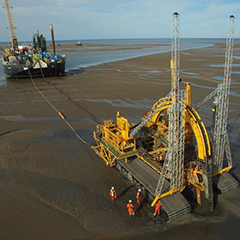Jan De Nul Group wins two DPC Innovation Awards, one for Project Design in Open Water (trenching tools Sunfish and Moonfish) and another for Project Design in Inland Dredging (engineered sediments for flood control dyke construction).
The Dredging & Port Construction Innovation Awards 2016 are one of the industry’s most prestigious awards. The awards are organised by the industry’s leading trade magazine, IHS Dredging & Port Construction and boasts a new style of awards format within the dredging community. The DPC Innovation Awards consist of 13 categories focussing on the most innovative project solutions the dredging industry has to offer. Jan De Nul Group won the award for two categories: ‘Innovation in Project Design – Open Water Dredging’ and ‘Innovation in Project Design – Inland Dredging’.
Awarded innovative projects
The Award for Innovative Open Water Dredging Project went to the in-house engineering and construction of two trenching machines Sunfish and Moonfish for the Race Bank Project (UK). Jan De Nul Group continuously invests in own techniques and tools to execute its projects. Therefore, the Group has a specialist in-house Design and Engineering Department.
Working closely with DONG on the Race Bank project Jan De Nul designed and built these two unique trenching machines. The Sunfish is designed to be able to install and bury the 220kV export cables in the salt marsh area over the first 2 km from the coast, the Moonfish is designed to bury the cable in the mud flats from the end of the grasslands offshore to the jointing point with the offshore cable.
The Sunfish can work in water depths up to 5m to bury cables to a depth of 1.5m using a V shaped plough and is fitted with extra wide low ground bearing tracks. Both these features are designed to minimise the disturbance to the environmentally sensitive salt marsh. Another innovation for the Sunfish is the automatic roller deploy and recovery system. This avoids the traffic of people or support machines over the salt march.
The Moonfish takes over the cable burial in deeper water with greater burial requirement and can work in water depths up to 250m. Jan De Nul designed the Moonfish with a similar low ground bearing system as Sunfish, but using a chain cutting technique to allow trench depths of up to 6m. This trencher is also able to operate in both dry and in wet conditions and has an integrated slack cable management system to avoid damage to the cable while being feed into the trencher.
Both machines have been designed to be extremely reliable as access over the long tidal salt marshes for recovery or repairs would be very difficult.
The works on Race Bank were successfully executed between May and August 2016, setting a new benchmark for shallow cable installation and burial in environmentally sensitive areas.
The Award for Innovative Inland Dredging Project Design went to the use of engineered sediments for the construction of a flood control dyke in Vlassenbroek (Belgium). Jan De Nul Group constructed two flood control dykes of 800 m each using dredged sediments to protect the community of Vlassenbroek against flooding of the river. The dyke forms part of the broader Sigma Plan, a Flemish flooding control programme for the river Scheldt.
Envisan, the environmental subsidiary within the Jan De Nul Group, elaborated an innovative technique to construct the dike core with engineered sediments. This technique was geotechnically analysed and modelled in detail. Simultaneously, an elaborate test campaign was set up, examining in a laboratory the suitability of 20 potential additives in different concentrations.
Following these lab tests, pilot studies were also carried out on the more promising results and this led to a final design was then verified by independent design and engineering offices. Research and design formed as such a very important part of this project.
The used sediments come from dredging works in the Scheldt between Melle and Gentbrugge. They were brought in over water and offloaded by means of an ingenious system based on concrete pumps. The additives were added near the site, before the material was inserted in the dike profile.
About Jan De Nul Group
Innovation, expertise and sustainability. These are the corner stones of Jan De Nul Group’s success. Thanks to its skilled employees and the world’s most modern fleet, Jan De Nul Group is a leading expert in dredging and marine construction activities, as well as in specialized services for the offshore industry of oil, gas and renewable energy. These core marine activities are further enhanced by Jan De Nul Group’s in-house civil and environmental capabilities offering clients a complete package solution.
Our professional and innovative solutions are trusted across the industry. Whether it concerns the construction of the new locks in the Panama Canal or a new port complex in Western Australia, together with our customers, we build for further economic development.
About IHS Dredging and Port Construction and the Innovation Awards
The leading international magazine for the world of marine civil engineering.
http://magazines.ihs.com/Dredging-and-Port-Construction/
The inaugural DPC Innovation Awards are the first universal benchmark of quality within the dredging and port construction industry; the rigorous judging process involved companies from all over the world submitting their entries to be judged by elite industry experts, making the DPC Innovation Awards the most coveted industry accolade.


























